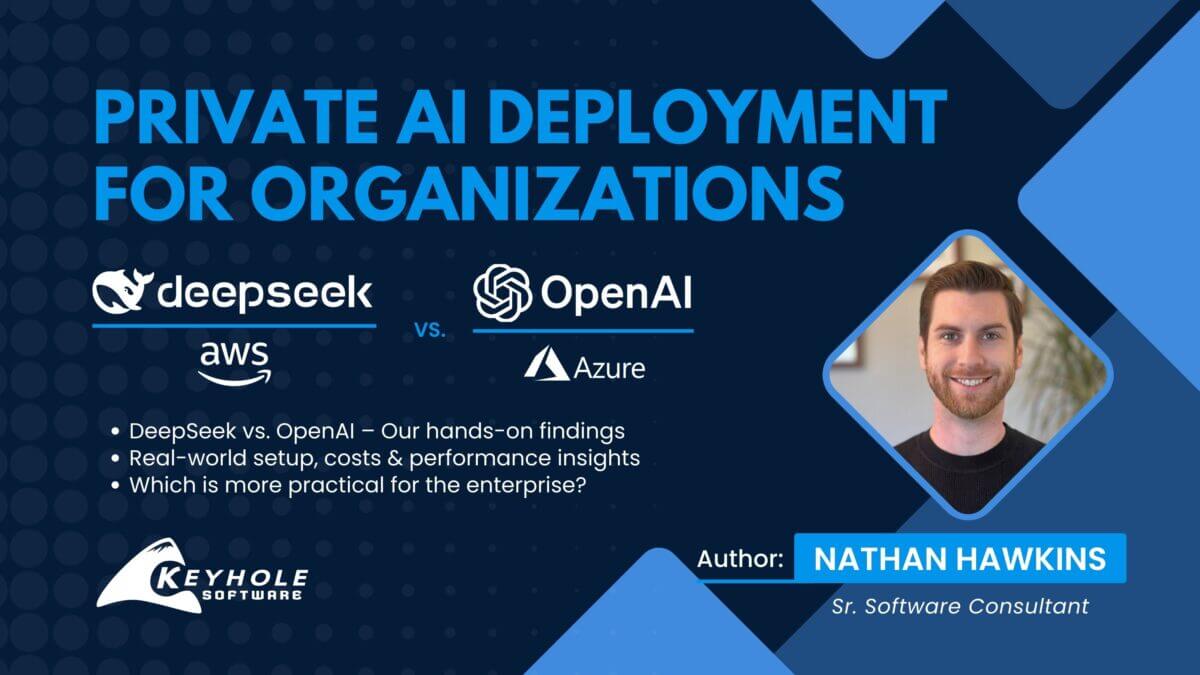How to Migrate Legacy Applications to AWS or Azure (With Real Examples)
August 19, 2025
A familiar challenge for many businesses is knowing when it’s time to modernize. Legacy applications that once ran smoothly on in-house servers start to feel like a burden as competition increases and technology advances. At Keyhole Software, we help companies migrate legacy applications to AWS or Azure to stay ahead. We take what already works and move it to a cloud environment that is secure, scalable, and ready for the future.
Let’s walk through the key strategies and considerations we use in real-world projects, so you can feel confident taking the next step.
Understanding the Challenges of Moving to the Cloud
Legacy applications often contain years of carefully developed features and a lot of data. Moving them to the cloud, whether to AWS or Azure, comes with real risks. We see this every time a client approaches us for help.
Avoiding Risk and Minimizing Downtime
Any change to your production environment has inherent risks. For legacy applications, the risk of data loss or a critical service outage is even higher. We approach this carefully by assessing the full production environment before any move. Our goal is to make sure you’re not exposing your application to unnecessary disruptions during migration.
Strategies to Migrate Legacy Applications to AWS or Azure
Over the years, we’ve identified three strategies that consistently help reduce risk and increase success when migrating legacy applications to AWS.
Leverage AI for Legacy Code Analysis
Legacy code bases can be messy. Sometimes, no one in the organization fully understands how it all works anymore. That’s why we use AI tools to scan the code base. These tools help us identify dead code paths, critical processes, and dependencies in a visual format. It saves countless hours and makes it easier to prioritize what truly needs to be migrated.
Start with Your Data Model
Once we have a clear understanding of your application’s code, we turn our focus to the data model. Legacy applications often rely on specific data storage systems and file structures. In the cloud, these may need to be re-architected. We ask questions like:
- Where is your data stored?
- What does your data persistence look like?
- Do you have file uploads or stateful elements?
On-premises applications typically take these for granted, but they need special care when you migrate legacy applications to AWS.
Evaluate and Adapt the Application Architecture
On-premises systems were designed with local network speeds and direct server access in mind. Once you’re in the cloud, everything changes. Cloud-based deployments need to handle latency and ensure high availability. We review the architecture to identify parts that need to be modernized:
- Are there hard-coded IPs or direct database calls that won’t work in the cloud?
- Can the app be containerized using Docker or managed with Kubernetes?
- Are there legacy dependencies that need to be swapped for modern equivalents?
In some cases, we recommend replacing on-premises message brokers like RabbitMQ with cloud-based alternatives or redesigning workflows entirely.
Key Considerations for a Successful Migration
The technical steps of migration are only part of the story. Other factors come into play when moving from on-premises to AWS or Azure.
Security and Role-Based Access
Security is a top priority. We ensure that role-based access controls are in place and updated to work in the cloud. We also use code scanning tools to find vulnerabilities that could be exploited once the app is exposed beyond your firewall.
Network Design and Cloud Readiness
Cloud environments don’t look like traditional data centers. We work with you to design a network that supports the performance and security needs of your application. This includes defining access control, deploying proper load balancers, and making sure your cloud network architecture aligns with your goals.
Key Takeaways for a Smooth Migration
Here’s what we’ve learned after years of helping clients migrate legacy applications to AWS or Azure:
- Start with a thorough assessment of your code, data, and application architecture.
- Use AI to map complex code bases and save time.
- Plan for cloud-native architecture, including containers and orchestration.
- Address security, network design, and operations as core parts of your project.
- Work with a team experienced in modernizing legacy applications.
At Keyhole Software, we know that moving to the cloud is more than a technical project; it’s a critical step in staying competitive. We’re ready to help you take this step with confidence.
Let Us Help You Migrate Legacy Applications to AWS
If you’re ready to migrate legacy applications to AWS or Azure and don’t want to leave it to chance, our team at Keyhole Software is here to guide you. We’ve done it for clients across industries, and we’ll make sure your migration is smooth and secure. Let’s talk about how we can help you modernize your applications and set your business up for the future. Contact us today.
More From Zach Gardner
About Keyhole Software
Expert team of software developer consultants solving complex software challenges for U.S. clients.



![Featured image for “Service Highlight: Cloud Services [Cloud Agnostic, AWS and Azure]”](https://keyholesoftware.com/wp-content/uploads/cloud-services-basics.jpg)




